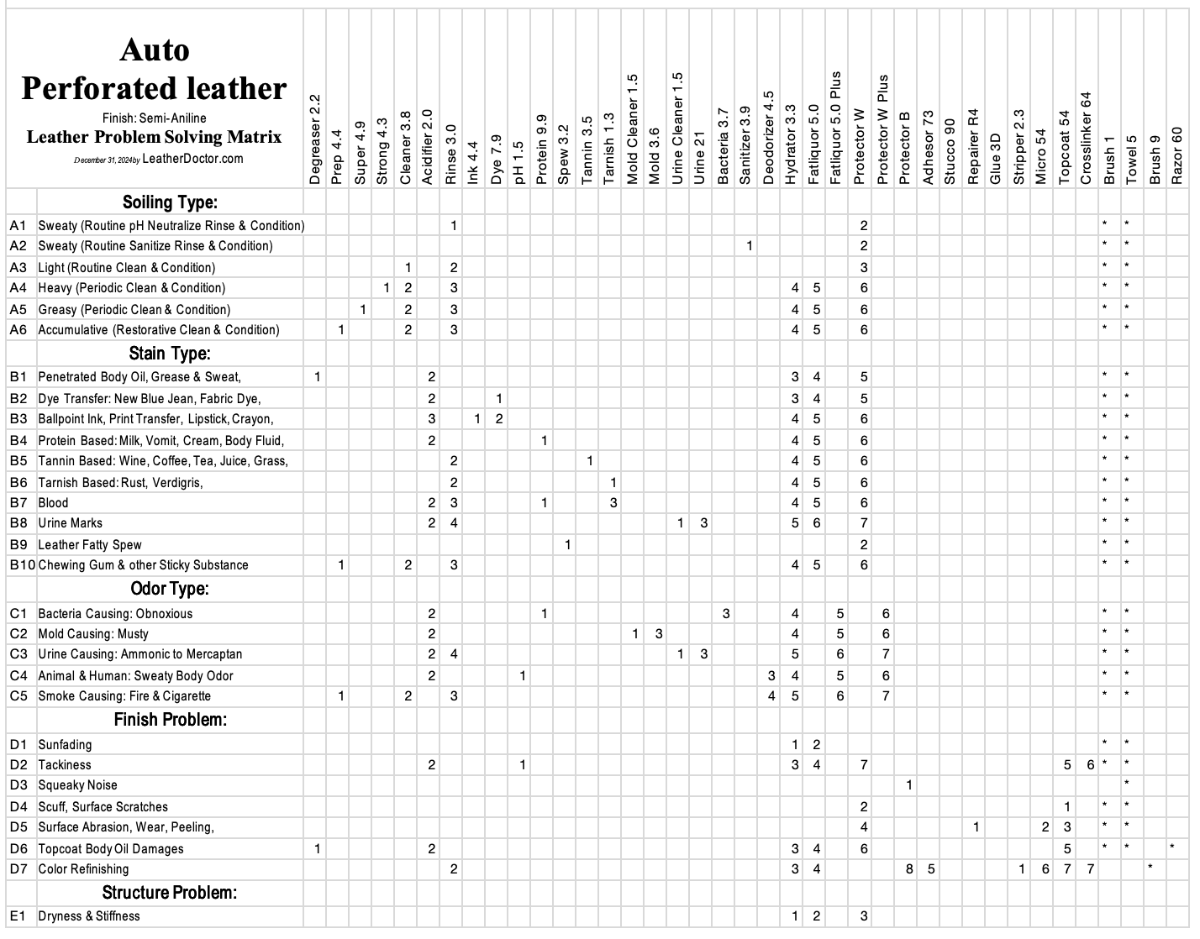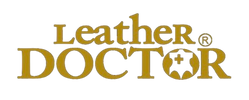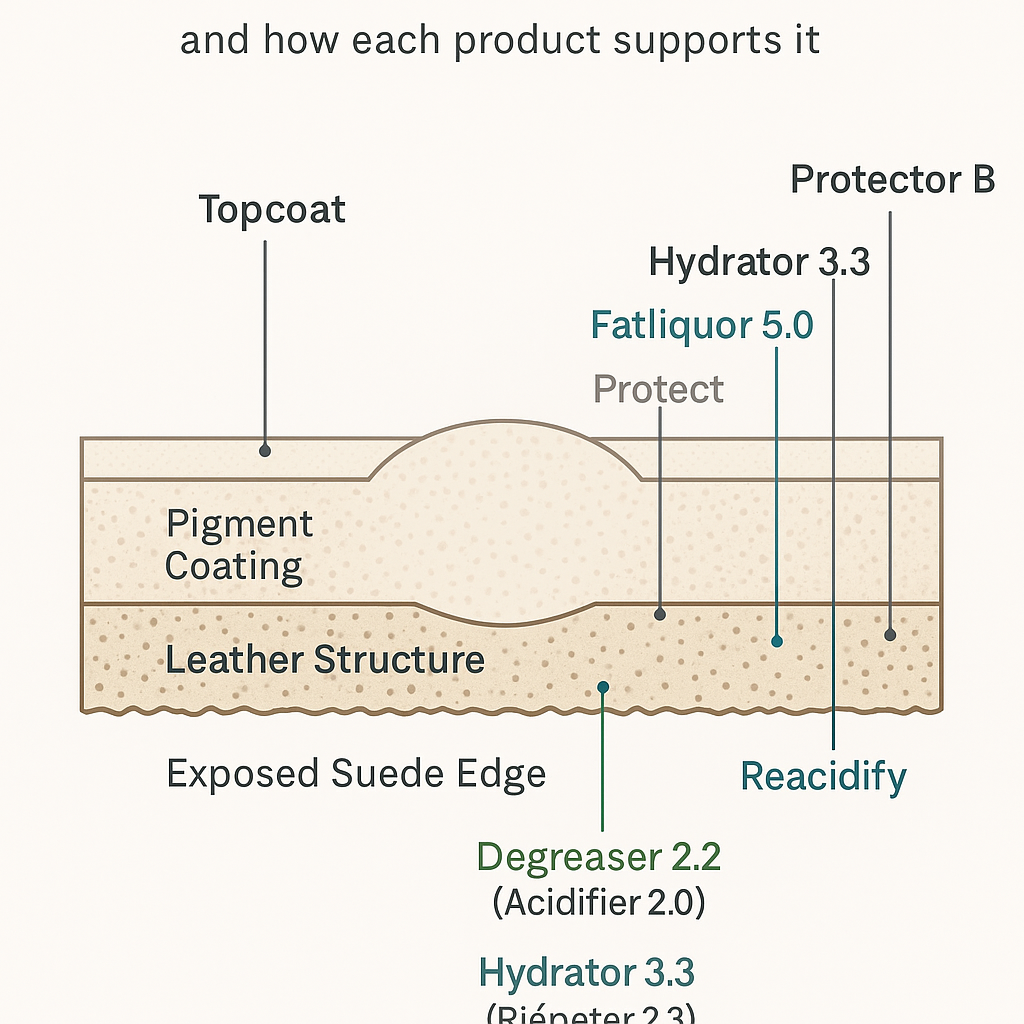Auto Perforated Leather Cleaner & Conditioner Kit AF3 by Leather Doctor is a preventive, routine, periodic, and restorative cleaning and conditioning system.
Perforation is created by machine punching small holes regularly in spaces, commonly found in leather car seats for seating comfort. Semi-Aniline perforated leather is aniline dyed through and has the surface coated with fine micro pigment. The perforated exposed suede naked cross-section shows aniline dyed and is more vulnerable to stiffness, creases, and cracks. The softness or suppleness derives from its fat liquor (fat and oil) content in the structure. Fat liquor fat and oil is VOC (volatile organic compound) and evaporates with aging or heat; leached out with water damage or an alkaline cleaning solution; when dry leather stiffs out, creases, and the perforated hole edges develop cracks. Fatliquor is the lifeblood of leather! Periodic replenishing perforated leather with fat liquor will ensure perpetual leather softness and strength.
Kit AF3 concentrates require 1178g or 1.3 quart distilled water to be mixed and added to 1.5 inches below the top of the 8oz bottles before use.
Instruction:
Prep 4.4 a leather-safe pH4.4 restorative cleaner, works on accumulated soiling, aged conditioners, chewing gum, silicone shine, sticky residue, and greasy soiling. The compound stain dye component will require Dye 7.9 for ballpoint ink, blue jean dye, crayons, leather belts, plastic ink print, newsprint, stamp pad ink, etc.
- Prep 4.4 is applied and works with a horsehair brush on heavily soiled areas and stains.
- Suspended soiling is towel extracted before dries until it shows clean and continues with general cleaning.
Cleaner 3.8 is a leather-safe pH3.8 mild cleaner that is particularly effective in emulsifying and suspending oily soils without common side effects. It works over after Prep 4.4 and extends the entire section without leaving a dry edge. Cleaner 3.8 holistic cleaning and rinsing sequence with Rinse 3.0 returns residue free to its pH chemistry integrity.
- Cleaner 3.8 concentrate 1: 64 is mixed with 224g distilled water or 1.5 inches from the top of the 8oz bottle before use.
- Cleaner 3.8 is applied and brushed with a horsehair Brush 1.
- Cleaner 3.8 suspended soiling is extracted with a dry absorbent towel until it shows clean and proceed with rinsing.
Rinse 3.0 is a pH3.0 rinse for removing suspended soil and strengthening the pH chemistry integrity of leather. It removes suspended soiling by towel extraction while neutralizing harmful alkaline residues and charging the leather ionic positive (+ve) to increase the attraction between the ionic negative (-ve) tanning agent, dyestuff, and fat liquor from tackiness, bleeding, and stiffness.
- Rinse 3.0 concentrate 1: 80 is mixed with 224g distilled water or 1.5 inches from the top of the 8oz bottle before use.
- Rinse 3.0 after Cleaner or identify, inspect, test, and dry soil removal before application.
- Rinse 3.0 is applied, and brushed with a horsehair Brush 1.
- Rinse 3.0 suspended soiling is extracted with a dry, absorbent towel, and proceed with hydrating.
Hydrator 3.3 is a pH3.3 hydrating conditioner to relax and stretch out leather stiffness, creases, and wrinkles before fat liquoring. It facilitates colloidal water movement, reactivating the dormant dyestuff to resurface and reducing the leather surface inter-facial tension for an even appearance.
- Hydrator 3.3 concentrate 1: 25 is mixed with 218g distilled water or 1.5 inches from the top of the 8oz bottle before use.
- Hydrator 3.3 is applied and brushed with a horsehair Brush 1 with a deep even saturating appearance, massaged, and stretched to dimension.
- Hydrator 3.3, wicked soiling is extracted with a dry, absorbent towel, and proceed with fatliquoring.
Fatliquor 5.0 is a pH5.0 micro-emulsion of fat, oil, and water for conditioning leather to its original softness and strength. In application, the water-encased fat and oil molecules break free when the attraction between the leather protein fibers takes place. The excess free water wicks out leaving a breathing space behind for Nubuck's natural transpiration.
- Fatliquor 5.0 concentrate 1: 5 is mixed with 189g distilled water or 1.5 inches from the top of the 8oz bottle before use.
- It is applied and redistributed with a brush or pad for even saturation and leaves to dry naturally.
- It is repeated each cycle water contents evaporate leaving behind the fat and oil content until it absorbs no more.
- Fatliquored leather fullness is allowed natural drying for extra softness.
- Fatliquored desired suppleness is further staked, massaged, and flexed accordingly with a little wet back with Hydrator 3.3 until dry.
Conditioner W is a nonstick, rub-resistant, non-film-forming conditioner that imparts a soft waxy feel to shield the detrimental effects of sticky soiling. Its breathable barrier increases resistance to wet and dry rubs, thus reducing stretch, scuff, and abrasion.
- Conditioner W concentrate 1:19 is mixed with 217g distilled water or 1.5 inches from the top of the 8oz bottle before use.
- It is applied, spread with a brush or a folded towel, is left to dry, and ready to use.
- Protector B concentrate is to be mixed with 215g distilled water 1: 19 or 1.5 inches from the top of the 8oz bottle before use.
- Protector B is applied and spread by brushing or padding and is ready to use when dry.

8: Auto Perforated Leather - Leather Problem Solving Matrix
How to Use this Vachetta Leather Problem-Solving Matrix?
- This matrix categorizes common issues with Vachetta into five groups:
- Soil, Stain, Odor, Finish, and Structure (listed in the left column).
- Corresponding recommended products are displayed across the top row.
- Each number within the matrix indicates the steps required to address the problem holistically.
For example:
If a leather issue involves an unknown compound that combines soil, stain, and odor, follow the sequence across the matrix, combining necessary steps from each category.
The process should always conclude with:
- Hydrator 3.3 to rehydrate and relax the leather.
- Fatliquor 5.0 to replenish lost fats and oils, restoring suppleness.
- Protector B conditioning the leather for ongoing durability.
People Also Ask:
A: How to Identify Leather Stains?
B: What is a Systematic Cycle of Care?
C: What is a Preventive Care System?
D: What is a Routine Care System?
E: What is a Periodic Care System?
F: What is a Restorative Care System?
G: Technical Help and Support?
A: How to Identify Leather Stains?
Stain identification is crucial for effective treatment and is based on six key factors:
Appearance, Odor, Color, Feel-of-Hand, Location, and Buildup or Absorption.
Appearance
- Observing how the stain looks can indicate whether it is a spill, rub-on, penetration, or surface deposit.
- Some stains may cause dye or finish damage, revealing changes in the leather’s color or texture.
Odor
- Smelling the stain can help identify its source.
- Common odors include:
- Moldy (fungal growth)
- Smoke (fire or cigarette exposure)
- Putrid (decaying organic matter)
- Ammonia (urine contamination)
Color
- Color provides a clue to the staining substance but can change over time due to oxidation.
- The leather’s natural color may also influence how the stain appears.
- Red stains: Could be from wine, blood, lipstick, nail polish, or beverages.
- Blood stains: Can oxidize and shift from red to tan, then to black.
Feel-of-Hand
- Touching the stain helps determine its type:
- Sticky: Likely from candy, beverages, or sugary substances.
- Brittle and stiff: Could be nail polish, paint, or shellac.
- Greasy smear: Often caused by lipstick, oils, or butter.
Location
- The stain’s location on the leather provides hints about its origin.
- Headrests & armrests: Usually stained by body oil, sweat, and grease.
- Seat cushions: Often show food or beverage spills.
Buildup or Absorbed
- Stains can be surface-level (built-up) or deeply absorbed into the leather.
- Built-up stains (common on pigmented leather) include paint, food residue, and ink.
- Absorbed stains (common on nubuck, aniline, and unfinished leather) include wine, tea, and coffee.
- Combination stains: Some stains contain both absorbed and surface elements, such as lipstick, ink, and mustard.
- Protein-based stains: Examples include blood, dairy, and egg-based spills.
- Oil-based stains: Often come from grease, butter, and lotions.
- Colloidal stains: May require specialized treatments.
Additional Considerations
- Sweat stains can chemically alter leather, causing tackiness (when dry) or sliminess (when wet).
- Dye stains may show up when wiping with a white towel—this indicates color crocking.
- Fatliquor leaching (spew) appears as a milky film and causes leather to become stiff and prone to cracking.
By carefully identifying stains, you can apply the appropriate Leather Doctor® solutions to restore leather to its original beauty.
B: What is a Systematic Cycle of Care?
A systematic cycle of care includes preventive, routine, periodic, and restorative levels of care to bring leather suppleness, and appearance at all times high.
C: What is a Preventive Care System?
A preventive care system is the application of non-stick, rub-resistant protection to increase the leather's resistance to wet and dry rubs, thus reducing stretch, scuff, and abrasion with Protector B and Protector W.
D: What is a Routine Care System?
- Routine care requires Rinse 3.0 and Protector B.
- It includes dust cleaning and attending to spots and stains as required.
- It neutralizing sweat or perspiration from shifting alkaline with Rinse 3.0 prevents leather tackiness.
- It sanitizing the leather with Sanitizer 3.9 keeps a hygienic bacteria-free surface.
- Routine care surface conditioning with Protector B reduces surface wear and improves appearance.
E: What is a Periodic Care System?
Periodic care requires frequent attention to body contact on the headrest and armrest which get the most body oil, grease, and sweat.
- Periodic care is recommended before soiling causes damage to the leather finishing.
- It keeps leather consistently clean and healthy at all times.
- Its cleaning and rinsing with Cleaner 3.8 and Rinse 3.0.
- Its care hydrating, fatliquoring, reviving, and conditioning with Hydrator 3.3,
- Fatliquor 5.0, and Protector B return the leather to the highest level of suppleness and appearance.
F: What is a Restorative Care System?
- Restorative care is the ultimate salvage system that removes accumulated soiling and aged conditioners.
- Restorative cleaning requires Prep 4.4, Cleaner 3.8, and Rinse 3.0.
- Restorative conditioning requires Hydrator 3.3, Fatliquor 5.0 and Protector B.
G: Technical Help and Support.
Your opinions and insights are precious and will help us solve your leather problem more efficiently.
Updated January 1, 2025, by Roger Koh.















